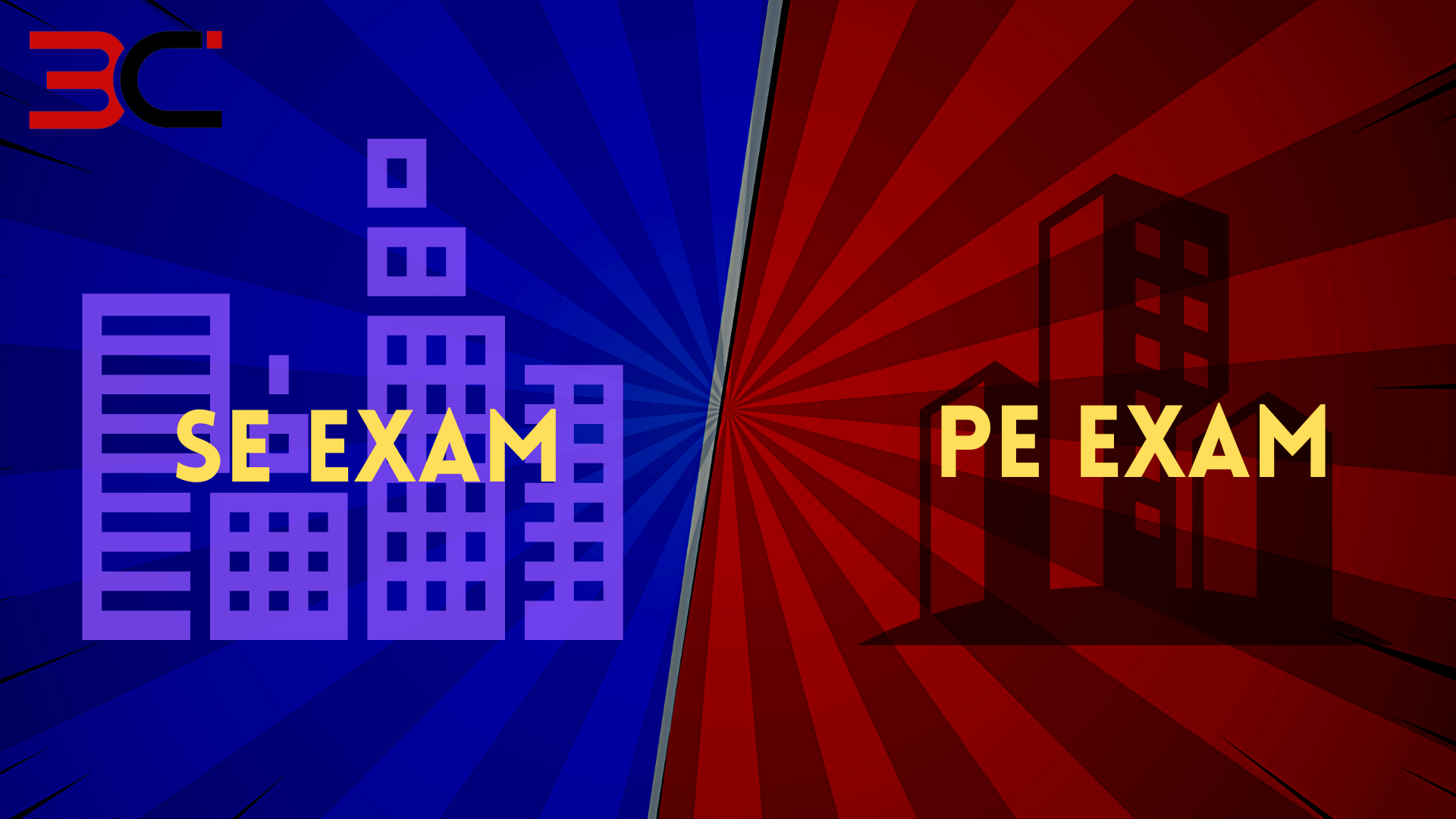The Principles and Practice of Engineering (PE) exam is a licensure test offered in several engineering disciplines. It covers the principles common to all branches of engineering, including mathematics, natural sciences, computer science, and engineering ethics. If you are considering a career as an engineer, you will need to pass the Structural Exam (SE) under the PE to become licensed as a professional engineer.
In this article, we will break down everything you need to know about the Principles and Practice of Engineering (PE) exam, specifically the Structural Exam (SE), and how you can study for it.
If you are wondering, “What is the PE & SE exam, and why should I take it?” Then, this is a must-read.
The Definition of the Principles and Practice of Engineering, or PE Exam?
A minimal degree of proficiency in a certain engineering subject is tested on the Principles and Practice of Engineering (PE) exam. It is intended for engineers having at least four years of post-college job experience in their preferred engineering subject.
Who Offers the PE & SE Exams?
The Principles and Practice of Engineering (PE) exam and the Structural Exam (SE) are administered by the National Council of Examiners for Engineering and Surveying, or NCEES. It is a non-profit organization that provides standardized exams in several engineering disciplines.
In the US, these exams are a requirement for licensure as a professional engineer (PE) in all 50 states, along with Washington, D.C. If you want to work in structural engineering, you must sit for the Structural Exam (SE). Although the exam is offered in all 50 states, the content of each exam may vary slightly based on state-specific regulations.
Here are the states (including Washington D.C.) in the US, where having a PE license is preferred –
Alabama, Alaska, Arizona, Arkansas, California, Colorado, Connecticut, Delaware, District of Columbia, Florida, Georgia, Hawaii, Idaho, Illinois, Indiana, Iowa, Kansas, Kentucky, Louisiana, Maine, Maryland, Massachusetts, Michigan, Minnesota, Mississippi, Missouri, Montana, Nebraska, Nevada, New Hampshire, New Jersey, New Mexico, New York, North Carolina, North Dakota, Ohio, Oklahoma, Oregon, Pennsylvania, Rhode Island, South Carolina, South Dakota, Tennessee, Texas, Utah, Vermont, Virginia, Washington, West Virginia, Wisconsin, Wyoming
While this exam can be taken at any time, it is generally recommended that you take it as early in your studies as possible so you don’t feel rushed to complete your education while preparing for the exam.
Why is the PE Exam Important?
In order to work as a professional engineer (PE), you will need to pass the PE exam. While this exam is not required for employment as an engineer, it is required for licensure. As a PE, you will have the authority to design and oversee construction projects. The PE exam covers the fundamental principles applicable to all branches of engineering. This exam is designed to ensure that engineers have the necessary skills and knowledge to provide safe and efficient technology for all people.
What is a Structural Exam (SE) and Its Content?
The Structural Exam (SE) is a subtest of the PE exam that includes sections on the design of buildings and other structures. To demonstrate your proficiency in civil engineering, you must pass this vital licensing test.
A minimal degree of structural engineering proficiency is tested by the Structural Exam (SE). Your capacity to create secure designs for structures or bridges will be tested by this exam. And this will be measured, particularly in seismically active and windy regions, in two components – Vertical and Lateral.
It will take 16 hours to complete this open-book exam. It will take place over two days –
- On Friday – The 8-hour Vertical Forces component test is available only on Fridays. Gravity loads and lateral earth pressures are its main topics.
- On Saturday – The 8-hour Lateral Forces component is available only on Saturdays. It concentrates on earthquake and wind loads.
The SE Exam Questions –
The SE exam may have sections on the types of materials used in building design. These include concrete, masonry, wood, and steel. Questions may ask how to manage the stress on a given element or how a load is distributed among several elements.
The exam may also ask how the type of material or construction method affects the safety of the structure. Questions may also ask how engineers predict the amount of load an element will sustain.
Questions of the SE exam may cover topics such as –
- Structural systems
- Basic engineering concepts and applications
- Engineering economics
- Load analysis
- Material selection
- Design intent
- Utility of load-bearing elements
- Mechanics and materials
- Communication
- Human factors and safety
- Design issues and considerations
Aside from the above topics, the exam may include mathematical questions that use basic algebra to solve problems.
Why is the SE Exam Important?
Knowing your benefits from passing the SE exam may occasionally inspire you to study when you are not in the mood. Let’s examine what you will truly acquire if you take and pass the SE exam –
- Higher Authority
For having the “SE” designation after your name, architects, contractors, or project owners will be more likely to agree with your recommendations.
- Legal Credential
You will have the authority to draw construction plans for schools and hospitals. The SE title will also make you more appealing to potential employers if you have some expertise working with OSHPD and DSA. It refers to prospective advancements within your current employer.
- More Knowledge
Even if you have complete trust in your technical skills, you can never tell what you could learn throughout your SE preparation. Over 100 to 300 hours of study will make you more knowledgeable in civil engineering than before.
- Higher Confidence
It will give you more confidence to know that you passed such a challenging exam. Knowledge, confidence, and authority all kind of go together. So, it won’t take much time to increase the confidence level.
- Professional Appreciation
Greater respect for the other SE engineers in your immediate vicinity will make you modest and kind, which is a very valuable quality in civil or structural engineering jobs.
- Salary Increment
Since you have the “SE,” you will be promoted soon. As a result, your demand will increase along with your salary. To become a level 3 civil engineer, getting a PE certification is very important. When you look at the following chart of civil engineers based on years of expertise, you will get a better idea –
Source: salary.com
Taking all the advantages into account, we outline some insightful SE exam study tips that will enable you to have a strong foundation. You will get additional knowledge about the SE exam’s procedure as well.
Information on Passing the PE & SE Exam
To help get you started, we have compiled a list of study materials, courses, and exam strategies for the Structural Engineering (SE) subtest of the PE exam.
Strategies to Pass the PE Exam
The key to passing the PE exam is to start studying early and to make sure you understand the concepts and fundamentals of engineering. According to the official NCEES website, you are allowed to bring the following PE & SE exam study materials –
- Permissible resources
- Training resources
- Exam standards
- Accommodations for those with disabilities
- Locations of exam centers
- Loose papers (with certain restrictions)
Strategies to Pass the SE Exam
The number of questions on the Structural Engineering (SE) exam is fixed at 80 and is administered via computer. During the exam time, you will be able to review and change your answers. The exam is offered several times per year at various computer-testing sites throughout the United States. You will need to register with the NCEES to be able to schedule and take the exam.
| Pro Tip -The SE Exam has 2 components, and you must pass both of them within five years. It is not necessary to pass both 8-hour sections on the same exam administration. The second component can be passed once you pass the first one. |
The Best SE Exam Review Courses –
We have found two of the best SE exam review courses. Here is a briefing on these SE courses and their prices –
School of PE SE Review Course: One of the best refresher courses in structural engineering for both vertical and lateral forces. Students may attend either one separately or both together. Revision seminars and workshops will cover two separate review courses, which are –
- 60-hour Vertical Forces review
- 60-hour Lateral Forces review
| Key Features – |
| Class lectures will be recorded. Send inquiries to the instructors. Entry to a discussion forum.Calculator instruction for free. Repeating registration is free. |
| Course Fee for School of PE SE Review Course – |
| On-demand course: $1,190 + $1,190 = $2,380Live online course: $1,490 + $1,490 = $2,980 |
ASCE SE Review Course: There are 11 live lessons available for the ASCE SE review. With free on-demand recordings available up to the test date, you will gain teacher help throughout the live webinars. The course accepts two types of payments. They are –
- Individual Rate – It allows one person to access the course from a single computer.
- Group Rate – The sessions can be attended by any number of people from a single place.
| Key Features – |
| Classes are held every Monday and Wednesday. A pass is not required for the next course enrollment. Free enrollment in the next course with an ASCE guarantee. |
| Course Fee for ASCE SE Review Course – |
| Individual Rate – $1,295 (members)/ $1,895 (nonmembers)Group Rate – $1,845 (members)/ $2,345 (nonmembers) |
Aside from these SE exam review courses, you can also take a look at the following books for better SE exam preparation –
- NDS Special Design Provision for Wind & Seismic 2012
- AISC Seismic Design Manual 2nd Edition
- AISC Design Manual 14th Edition
- AASHTO 2012
- ASCE 7-10
- AISI Spec 2007
- IBC 2012
- ACI 318-11
- NDS 2012
- PCI Design Handbook 2010
Scoring and Reporting of Structural Engineering, SE Exam
Each question on the PE exam is given a weight based on the relative importance of the topic in the field of engineering. The PE exam is scored on a scale of 100 -190, with a mean score of 150. The Structural Engineering exam has a minimum passing score of 84. You will receive your score report two to four weeks after taking the exam.
PE & SE Exam Results
The State Licensing Board releases the results 10 to 12 weeks after the test. Candidates receive either a pass or fail mark (in a letter) based on performance that satisfies the requirements for this discipline’s minimal competence as evaluated by experts. Otherwise, you may access them online through your MyNCEES profile.
- For the vertical and lateral components, over 50% and 40% of SE Exams are respectively passed on the first try.
- Repeat test taker pass percentages hover around 35% in the vertical component and 40% in the lateral component.
Your Thoughts?
The Principles and Practice of Engineering exam, or PE exam, is a requirement for licensure as a PE in all 50 states. If you are interested in pursuing a career as a structural engineer, you will need to pass this exam. The Structural Engineering subtest covers topics related to the design and analysis of buildings and other structures.

